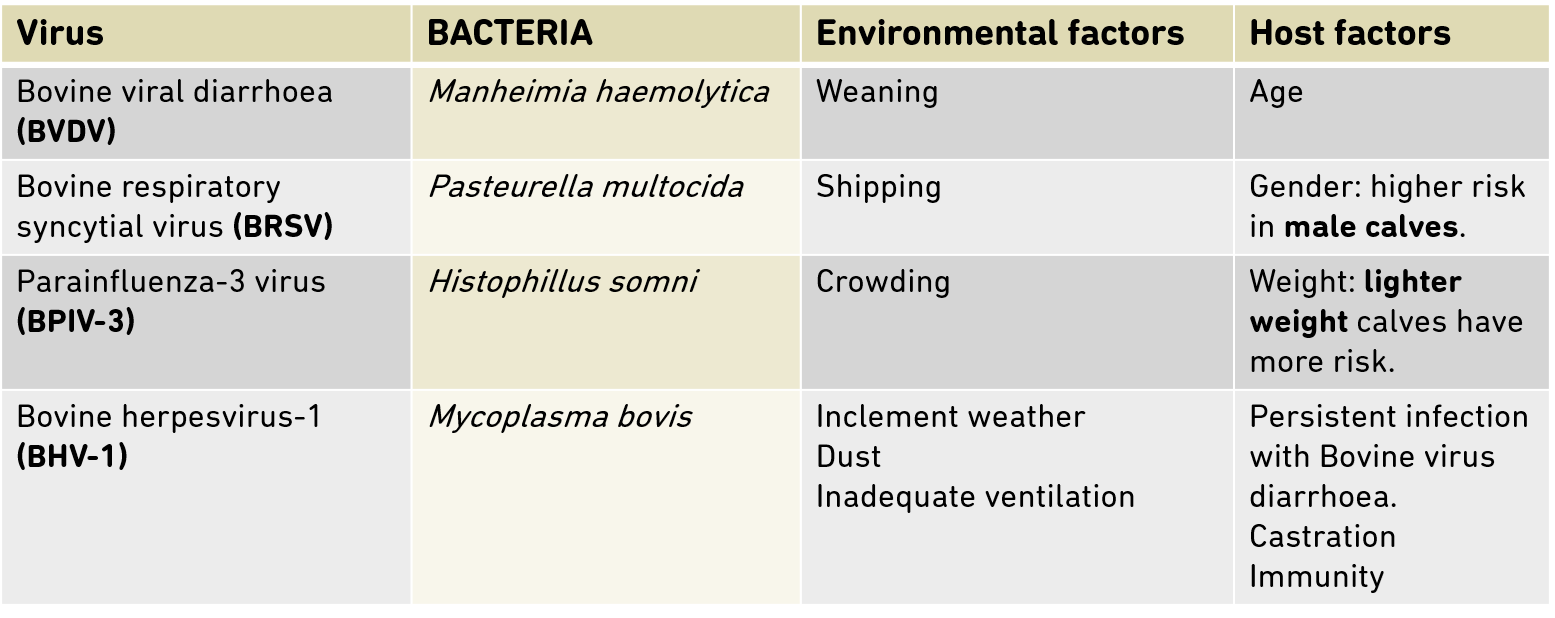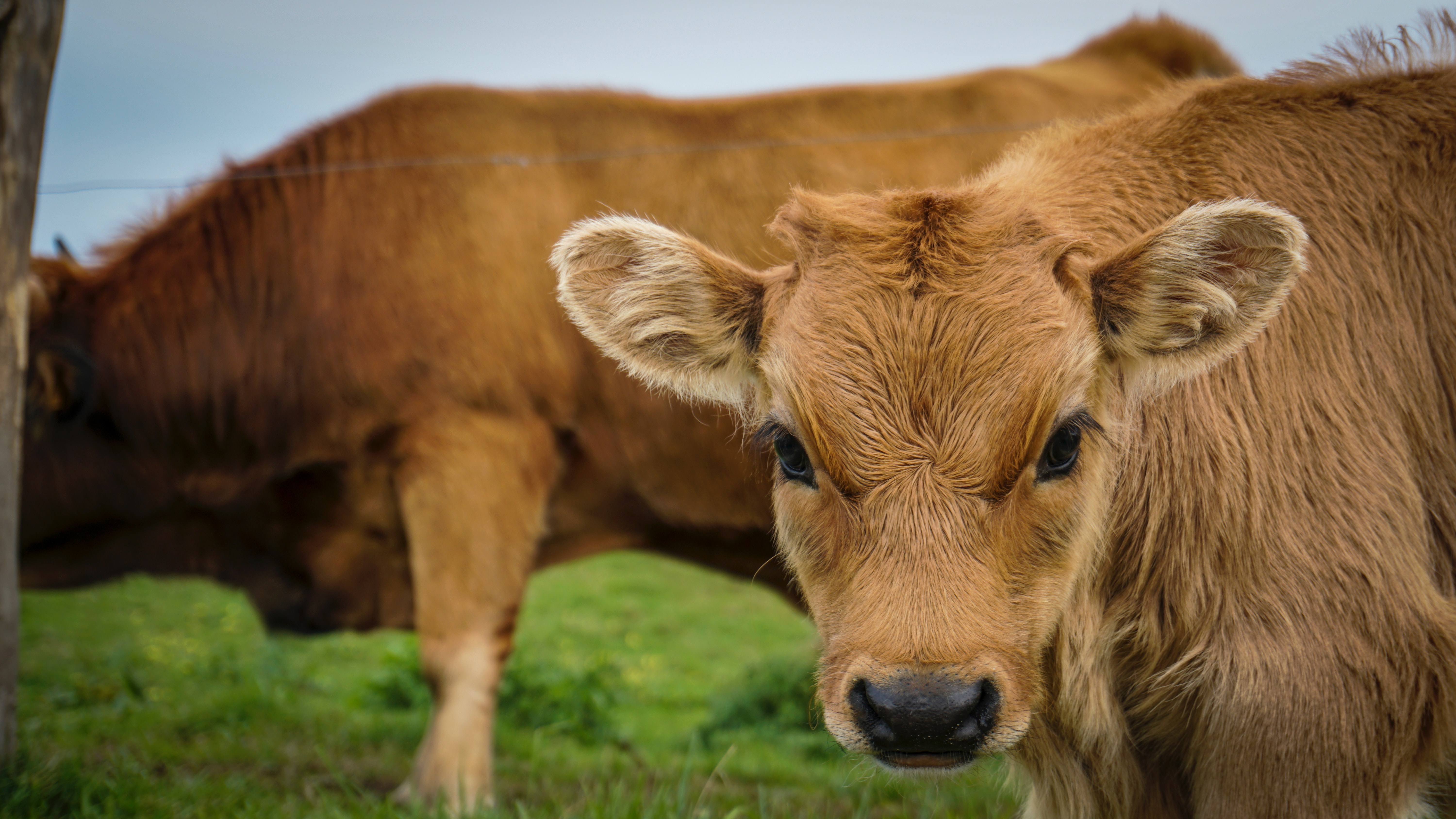Respiratory diseases in Cattle
Bovine respiratory disease (BRD) is one of the most economically important diseases in global cattle industries.(1–3) The global economic impact of BRD is estimated to be >$3 billion per year due to loss of production, increased labour expenses, drug costs and death of affected animals.(1,4,5)
An increased incidence of BRD is correlated with decreased average daily weight gain in calves after entering the feedlot. Also the presence of the disease has major consequences for performance and carcass traits.(6–8)
BRD is a multi-factorial disease involving interactions of viral and bacterial infections. It can be triggered by stress (either physical or physiological) due to adverse environmental conditions such as extremely bad weather, poor management, overcrowding and transportation.(1,8) A list with all the factors which may be involved in this disease is shown in Table 1.

BRD normally starts when a virus infects the epithelium of the upper respiratory tract and causes lesions, such as loss of cilia and goblet cells, leading to epithelial erosions. This could then progress to necrosis of the epithelium and adjacent lymphoid tissue. The injured tissue results in ineffective mucociliary clearance as well as lesions in the mucosa of the upper respiratory tract. It is this damage to the epithelium which is advantageous for bacterial pathogens, causing secondary infections and exacerbating the disease status.(1,9)
Manheimia haemolytica in particular, as well as other opportunistic bacteria, take advantage of this disturbed immune status to infect the animal. This bacteria is present at a higher density in nasal passages of stressed animals.(1) Previously Manheimia haemolytica was considered the main pathogen in fatal BRD cases but recent studies suggest that Pasteurella multocida is in fact most frequently reported in such cases.(1)

Clinical signs are typically observed in calves 7 to 10 days after a stressful event (e.g., arrival at the feedlot) but can be as late as 27 days after the stressful event. Clinical signs include nasal and ocular discharge, depression, anorexia, fever as high as 42ºC, increased respiratory rate and a moist cough. Acute pleuropneumonia is the major cause of death in animals suffering from BRD with serofibrinous lesions in the lungs and pleura being frequently found at necropsy.(1)
Management tools used to reduce the risks associated with BRD include attempts to minimize stress-associated immunosuppression, nutritional support, vaccination against target respiratory viruses and prudent use of antimicrobials in cattle at high risk of developing BRD. Effective therapeutic antimicrobials are essential to reduce disease severity, limit mortality and maximize profitability. The selection of an effective drug treatment must however be based on rigorous monitoring of antimicrobial susceptibility.(1,7)
LIVISTO has a wide portfolio of antimicrobial and anti-inflammatory products. Check with your distributor which LIVISTO products are approved in your area.
BIBLIOGRAPHY
- 1. Griffin, D., Chengappa, M. M., Kuszak, J. & McVey, D. S. Bacterial pathogens of the bovine respiratory disease complex. Vet. Clin. North Am. - Food Anim. Pract. 26, 381–394 (2010).
- 2. Mohamed, R. A. & Abdelsalam, E. A review on pneumonic pasteurellosis (respiratory mannheimiosis) with emphasis on pathogenesis, virulence mechanisms and predisposing factors. Bulg. J. Vet. Med. 11, 139–160 (2008).
- 3. Bateman, K. G., Martin, S. W., Shewen, P. E. & Menzies, P. I. An evaluation of antimicrobial therapy for undifferentiated bovine respiratory disease. Can. Vet. J. = La Rev. Vet. Can. 31, 689–96 (1990).
- 4. DeDonder, K. D. & Apley, M. D. A literature review of antimicrobial resistance in Pathogens associated with bovine respiratory disease. Anim. Heal. Res. Rev. 16, 125–134 (2015).
- 5. Kilgore, W. R. et al. Therapeutic efficacy of tulathromycin, a novel triamilide antimicrobial, against bovine respiratory disease in feeder calves. Vet. Ther. 6, 143–153 (2005).
- 6. Schneider, M. J., Tait, R. G., Busby, W. D. & Reecy, J. M. An evaluation of bovine respiratory disease complex in feedlot cattle: Impact on performance and carcass traits using treatment records and lung lesion scores. J. Anim. Sci. 87, 1821–1827 (2009).
- 7. Nutsch, R. G. et al. Comparative efficacy of tulathromycin, tilmicosin, and florfenicol in the treatment of bovine respiratory disease in stocker cattle. Vet. Ther. 6, 167–179 (2005).
- 8. Thiry, J. et al. Efficacy and safety of a new 450 mg/ml florfenicol formulation administered intramuscularly in the treatment of bacterial bovine respiratory disease. Vet. Rec. 169, 526–526 (2011).
- 9. Srikumaran, S., Kelling, C. L. & Ambagala, A. Immune evasion by pathogens of bovine respiratory disease complex. Anim. Heal. Res. Rev. 8, 215–229 (1996).
